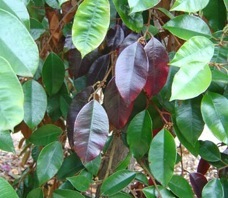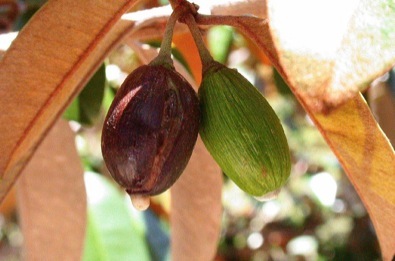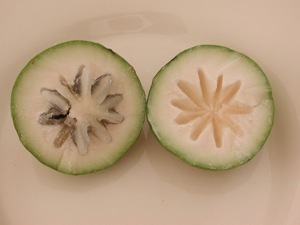Chrysophyllum oliviforme: “Chewy Olives”
“Turn left at the Satinleaf.”
That’s not an unusual direction in an area where Satinleafs grow, they are that distinctive. It was also the Satinleaf that lured the Spanish of Yore off their ships to look for gold. You know the old story: There was so much gold in the New World even the leaves were covered with it.
Dark green above, satin brown below, the tree became famous for its looks, but the fruit of the Satinleaf, also called the Olive Plum, is quite edible… well… chewable would be the more accurate description. You chew it for a long time before it feels safe to swallow. Think of it as gum on a tree.
It used to be a common tree — especially in south Florida — but one that has succumbed to development. It’s threatened in the wild but common enough in the landscape and the state’s been encouraging people to plant more of the evergreen.

Leaves are satiny copper underneath
Botanically it is Chrysophyllum oliviforme (kriss-so-FILL-um awl-liv-ih-FOR-mee) which in Greek and Latin means “gold leaf olive like.” To English speakers calling the tree the Satinleaf was a natural. The Indians, who used the tree, had a different view. The Seminoles called it, hilokwa inlokci yaca kita, the Mikasuki hacalo pi ha, which are phrases that literally means something like “chewing strangler fig berries” but means something akin to ‘chewing gum tree.’ The black fruit are sweet and definitely chewy. Somehow each new generation of kids seems to learn they are a local source of gum. Actually, they eat the pulp. spit out the seed, and chew the skin. The Satinleaf is related to the also edible. C. cainito, called the Star Apple.
Besides a mastication, the wood is hard but not easy to work. It’s used for fence posts, rafters and charcoal. Leaf decoctions are used to treat external cuts and abrasions. The species in the genus contain saponins, coumarins, alkaloids and glucosides.
Green Deane’s “Itemized” Plant Profiles
IDENTIFICATION: Large shrub, small tree, to 30 feet or more, upright branches, leaves, alternate, elliptic or oval, pointed, two to six inches long, leathery, dark and glossy above, coppery satin below. Flowers, white and small, fruit dark purple oval or oblong, about an inch long, rubbery, pulp lavender, milky, sweet, one half-inch seed
TIME OF YEAR: Spring
ENVIRONMENT: Hammocks, pine lands
METHOD OF PREPARATION: Ripe fruit eaten raw after much chewing, can be made into a jelly



